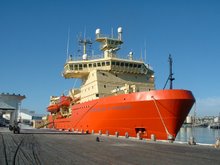ross ice shelf looking for evidence of glacial meltwater under the
surface. One of the ways we're doing this is with a complicated
sampling device called a helium channel. I think I mentioned these
earlier, as we spent the better part of two days assembling them (and
we still have 100-200 more to make). A two foot copper tube sits in
an aluminum channel with clamps, and the clamps are tightened,
sealing the copper tube with a ratchet wrench at both ends. The idea
is to seal the water sample (and the dissolved gas) inside the tube
by flowing water through the tube as soon as the rosette arrives on
the ship. Unfortunately, there is serious time pressure because the
helium will equilibrate with the air on the ship if it is allowed to
contact the air. And air bubbles left in the tube contaminate the
sample as well. So we storm the rosette with these clumsy metal
objects, hook plastic tubing up to both ends, tilt the tube upwards
(to help air bubbles flow out), turn the channel over, pinch the
plastic tubing to slow the flow, bang on the back of the channel with
a rubber mallet, and then seal the clamps with a power ratchet (nut
driver). With four hands, it'd be no problem. With two, it's comedy.
Anyway, if you do this correctly, the concentration of helium (and
neon) in the dissolved gases allows you to figure out what pressure
the gas bubbles were at when they were incorporated into the ocean.
The only way to supersaturate seawater with these gases is to release
them at high pressure, which only happens when bubbles in ice melt
under ice shelves.
It's a great idea and has worked very well in the past, but there's
gotta be an easier way.
Checking channel 53, we're at 77 south, 174 east. We'll be crossing
the date line sometime in the not to distant future, I think. Still
a long way to land, though.


No comments:
Post a Comment